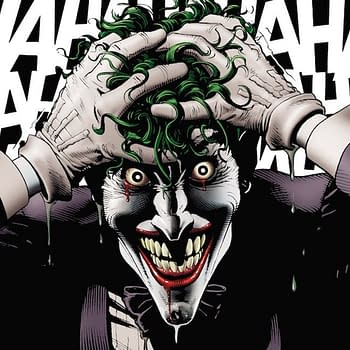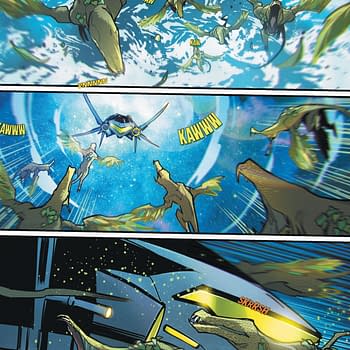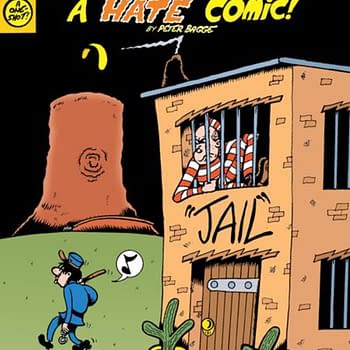Posted in: Comics | Tagged: Bettie Page, Comics, David Avallone, dynamite, entertainment, HRL, Joseph Michael Linsner
Writer's Commentary: David Avallone Talks Bettie Page #6
Dynamite has sent us a new writer's commentary, this one from David Avallone talking about Bettie Page #6. Covers by Joseph Michael Linsner and Scott Chantler, interiors by Esau Figueroa and Bane Wade.
* * * * *
Bettie starts a new arc and does a little international travel, as I play around with even more 1950s pop culture. There are spoilers ahead, so read the issue first and then come back for the behind-the-scenes story.

The covers: another gorgeous Linsner pin-up for the "A" cover. The "B" cover, by Scott Chantler, was done well in advance of me writing my full script, and it inspired a scene in the comic. I particularly love the guy hanging from the ceiling, holding his porkpie with one hand.
Page 1:
Last issue's cliffhanger was McKnight asking Bettie if she wanted to join his secret outfit. We pick up the scene and McKnight helpfully summarizes the previous five issues for any new readers. Bettie is still calling McKnight "Charlie" in spite of not actually knowing his first name. Among other things, it's my tribute to Lauren Bacall calling Humphrey Bogart "Steve" all the way through "To Have and Have Not", even though his name is Harry.
Pages 2-3:
Bettie does Basic. I have this feeling she would have been a pretty good shot, and she was an athletic woman. It was never my intention to turn her into some unbelievable La Femme Bettie super-agent… but if she's going to be out there throwing punches and firing guns, a little training wouldn't hurt. It was also a good place to emphasize the sexist culture of the time, and how isolated an ambitious woman would be in these circumstances.
Page 4:
Bettie returns to New York. She calls Jerry Tibbs on the phone. Jerry Tibbs is the photographer/policeman/friend from Bettie's real life, who helped inspire her to become a model, and who encouraged her to grow out her signature bangs.
Page 5:
Dynamite's PR person, Janie MacKenzie, sent the first issue of our comic to Playboy magazine, in the hope that they'd be interested in doing an article on it. To our surprise (and delight) they asked me to write a six page Bettie adventure for Playboy. It's called RED CHRISTMAS, and appears in the November/December 2017 issue, with beautiful art by Joseph Linsner. Here… I show where it fits into our story, and what happened right afterwards. The name of the Soviet agent – Kropotkin – is borrowed from the fantastic 1960s spy farce THE PRESIDENT'S ANALYST. The Coen Brothers must love that movie, too… they used the name Kropotkin for a Russian spy in BURN AFTER READING.
Page 6:
A little time passes, and Bettie takes the lead in a revival of PYGMALION. The parallel between that story and her own life – a woman being reshaped by a difficult mentor – is (obviously) intentional. Bettie is wearing Audrey Hepburn's costume from the movie musical version, MY FAIR LADY. In early 1953, the Broadway musical is still a few years away, as Bettie notes.
Pages 7-8:
Here's the sequence inspired by Chantler's great cover, now drawn by Esau Figueroa. Esau has done wonderful work on this book, and the exaggerated perspective on the silencer is a fine example. I am also a little too committed to reality to allow a silenced pistol in a small room to go "Phut" or "Koosh" or something like that. BANG is more accurate.
Page 9:
Speaking of commitment to reality, you can really see the handgun in panel one, and it's a Tokarev… a popular handgun with Soviet agents, and the kind of detail I like. The Russian spy's Marxist interpretation of PYGMALION is my favorite thing in the issue. I didn't think of it when I chose that play, and had no idea it was coming… but when I got to this moment it was so obvious — and to me, very funny — what a Communist would make of Shaw's play.
Page 10:
A good time to point out the work of ace letterer Taylor Esposito: the emphatic, nose-breaking SLAM, as Lyssa Druke returns to action. I really hope I someday get to write the story of Bettie meeting Lyssa's dad Jericho, and then, maybe… getting an introduction to Jericho Druke's old boss…
Page 11:
Bane Wade takes up the art for the rest of the issue, blending well with Esau's work on the first half of the book. Bettie tosses out the title of one of my dad's novels ("The Girl In The Cockpit," available on Amazon…) and they discuss the difficulty of being taken seriously. I didn't want to paint too rosy a picture, so Lyssa makes it clear she only gets respect because the boss – McKnight – gives it to her, and his boys follow his lead.
Page 12:
Lyssa mentions "Chief Parker"… the LAPD Chief at the time, who she was serving under before she came to work for McKnight.
Pages 13-14:
McKnight has borrowed a friend's office for the night. A friend whose office is on the 86th floor of the Empire State Building. Even in 1953… that can only be one man. McKnight references the NKVD, which is the precursor to the KGB. "Uncle Joe" is a reference to Joseph Stalin, who is probably days away from dying at this point, but Bettie doesn't know that.
Page 15:
We do a little exposition while Bettie and company head to Cannes by ship. International flight wasn't as common in 1953 as it is today. Ludvig Prinsky is a reference to Ludvig Prinn, a character created for the Lovecraft mythos by my late friend Robert Bloch. (You've heard of him: he also created Norman Bates.) The photo of Prinsky looks like Bob. Another reference to the casual racism of the age: even a relatively good guy like McKnight looks at Lyssa and thinks her cover should be "maid." Luckily, Bettie and Lyssa push back and McKnight gives in. This is also a nice page to draw your attention to the fine work of colorist Brittany Pezzillo.
Page 16:
McKnight's cover is "George Kaplan." George Kaplan is the man Cary Grant is mistaken for in Hitchcock's NORTH BY NORTHWEST: a non-existent CIA agent.
Page 17:
Who didn't have a crush on Gene Kelly in 1953? This conversation struck me as a good spot to let McKnight learn a little something about our Bettie Mae Page. Everything she says about herself on this page is drawn from the real Bettie, and things she actually said.
Pages 18-19:
Bettie hobnobs with the glitterati, and meets Endré Rajk, Hungarian film director. Endré strongly resembles my college drama teacher, Endré Hules, a Hungarian theater/film director and actor. In the real world, Endré was an émigré from behind the Iron Curtain, and an opponent to the Soviets. Here, he is a something quite different… the last name "Rajk" is drawn from a real world Hungarian collaborator. His first line "surely mademoiselle is an actress?" is similar to a line in Fellini's 8 ½, directed by a writer at a character played by Barbara Steele.
Page 20:
I regret that we won't get to spend any quality time with Ludvig Prinsky, but that's how it goes sometimes. Raymond Chandler once said (and I'm paraphrasing) that if you run out of story ideas, either find a dead body or have a new character walk in the room with a gun in their hand. Hey, if it ain't broke…






















